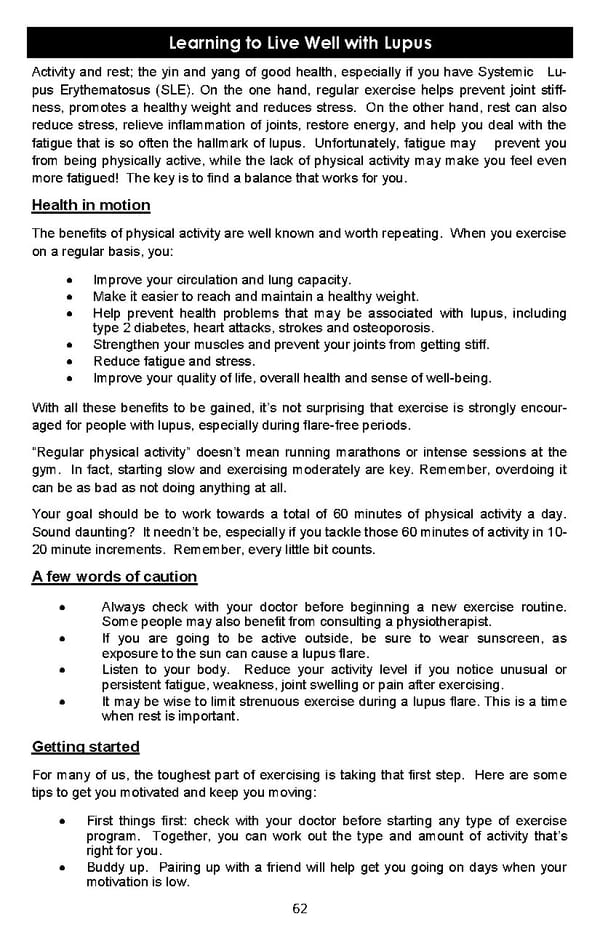Learning to Live Well with Lupus Activity and rest; the yin and yang of good health, especially if you have Systemic Lu- pus Erythematosus (SLE). On the one hand, regular exercise helps prevent joint stiff- ness, promotes a healthy weight and reduces stress. On the other hand, rest can also reduce stress, relieve inflammation of joints, restore energy, and help you deal with the fatigue that is so often the hallmark of lupus. Unfortunately, fatigue may prevent you from being physically active, while the lack of physical activity may make you feel even more fatigued! The key is to find a balance that works for you. Health in motion The benefits of physical activity are well known and worth repeating. When you exercise on a regular basis, you: • Improve your circulation and lung capacity. • Make it easier to reach and maintain a healthy weight. • Help prevent health problems that may be associated with lupus, including type 2 diabetes, heart attacks, strokes and osteoporosis. • Strengthen your muscles and prevent your joints from getting stiff. • Reduce fatigue and stress. • Improve your quality of life, overall health and sense of well-being. With all these benefits to be gained, it’s not surprising that exercise is strongly encour- aged for people with lupus, especially during flare-free periods. “Regular physical activity” doesn’t mean running marathons or intense sessions at the gym. In fact, starting slow and exercising moderately are key. Remember, overdoing it can be as bad as not doing anything at all. Your goal should be to work towards a total of 60 minutes of physical activity a day. Sound daunting? It needn’t be, especially if you tackle those 60 minutes of activity in 10- 20 minute increments. Remember, every little bit counts. A few words of caution • Always check with your doctor before beginning a new exercise routine. Some people may also benefit from consulting a physiotherapist. • If you are going to be active outside, be sure to wear sunscreen, as exposure to the sun can cause a lupus flare. • Listen to your body. Reduce your activity level if you notice unusual or persistent fatigue, weakness, joint swelling or pain after exercising. • It may be wise to limit strenuous exercise during a lupus flare. This is a time when rest is important. Getting started For many of us, the toughest part of exercising is taking that first step. Here are some tips to get you motivated and keep you moving: • First things first: check with your doctor before starting any type of exercise program. Together, you can work out the type and amount of activity that’s right for you. • Buddy up. Pairing up with a friend will help get you going on days when your motivation is low. 62
 Living Well With Lupus Facts Booklet Page 61 Page 63
Living Well With Lupus Facts Booklet Page 61 Page 63